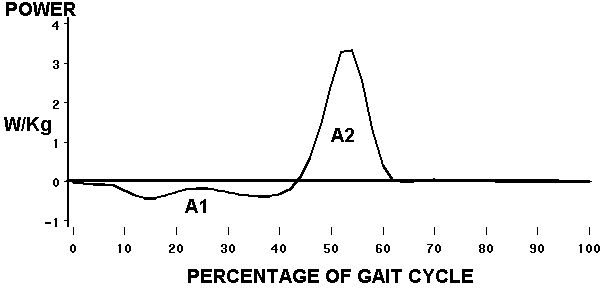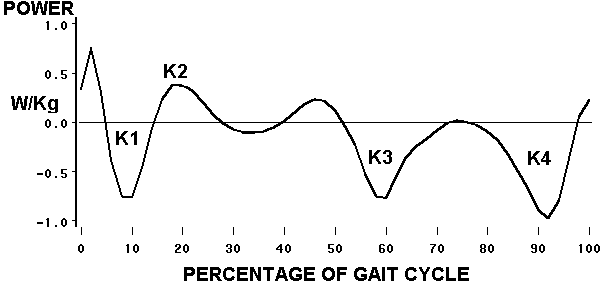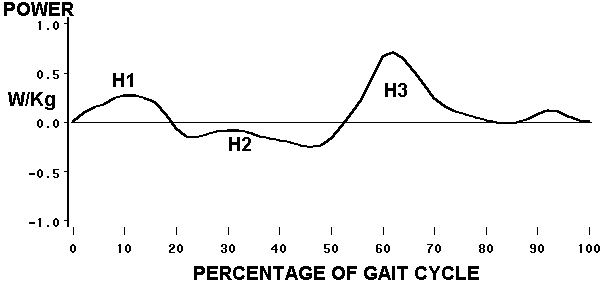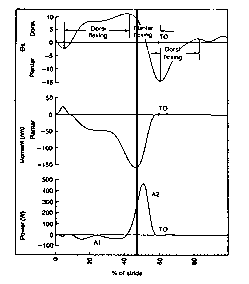Energy and power during the gait cycle
Power is Energy / time, the rate at which energy
- is created (positive power)
- or absorbed (negative power)
Structures in the body that can generate or absorb energy include
- muscles
- other soft tissue
Power is measured in Watts or Joules/second.

| These graphs, derived from data published by Winter (1987, Table 4.34b), summarize power at the hip, knee and ankle during normal gait.
Power is positive when the body generates energy through concentric muscle activity.
Power is negative when the body absorbs energy through eccentric muscle activity or elongation of soft tissue.
SAS program that produced these graphs
How joint power is calculated
|
|---|

|
|---|

|
|---|
POWER CURVE FOR THE ANKLE JOINT

|
A1: a region of negative power, corresponding to eccentric plantar flexor activity at the ankle during midstance and terminal stance.
A2: a region of positive power, corresponding to the concentric burst of propulsive plantar flexor activity during preswing.
|
|---|
POWER CURVE FOR THE KNEE JOINT

|
K1: a region of negative power, corresponding to eccentric knee extensor activity at during loading response.
|
|---|
K2: a region of positive power, corresponding to concentric knee extensor activity during midstance. This is followed by a period of negligible joint power during that period of time when the ground reaction force stabilizes the knee in extension.
K3: a region of negative power, corresponding to eccentric activity in the rectus femoris during preswing. At normal or slightly faster walking speeds, rectus femoris controls knee flexion.
K4: a region of negative power, corresponding to eccentric activity in the hamstrings during terminal swing.
POWER CURVE FOR THE HIP JOINT

|
H1: a small region of positive power, not always present, which corresponds to concentric hip extensor activity during loading response.
H2: a region of negative power, corresponding to eccentric hip flexor activity during midstance.
|
|---|
H3: a region of positive power, corresponding to concentric activity in the hip flexors during preswing and intial swing. Sometimes called "pull off," this is the muscular system's second largest contribution of propulsive power during the gait cycle.
CALCULATION OF JOINT POWER

| This figure simultaneously graphs three quantities against percentage of the gait cycle (on the horizontal axis):
- joint angle
The first curve's slope at any point in the gait cycle reflects the joint's angular velocity (w).
- joint moment (M)
- joint power (P)
At that instant during the gait cycle indicated by the bold vertical line, joint power is the product of joint moment and joint angular velocity.
P=Mw
Derivation of formula.
Definitions of these and other terms related to kinetics
|
|---|
Power can be a negative or positive quantity
When the muscle moment of force (M) and the direction of joint movement (w) are the same at a particular joint:
- power is a positive quantity
- energy is generated by concentric action in muscles crossing that joint.
When M and w are in opposite directions:
- power is a negative quantity
- energy is absorbed in eccentric muscle action and/or elongation of other soft tissue crossing the joint.
COMPARISON WITH BK AMPUTEE (Winter & Sienko, 1988)
- very small A2 propulsion
- compensated for by large loading response hip extension (H1)
- small knee power curves, even though the knee muscles are present
CLINICAL IMPLICATIONS:
- Plantar flexors provide important propulsive energy during "push-off"
- Hip flexors provide propulsive force during "pull-off"
- Knee power is relatively low, and often negative, indicating eccentric activity in knee extensors or flexors
- evidence of energy transfer by two-joint muscles, including rectus femoris (K3->H3)
- Timing patterns in the power analysis profiles indicate a "sequential development of power from the ankle to the hip joint" (Judge, Ounpuu, Davis, 1996, p. 674). Multiarticular muscles can transfer energy up the kinetic chain from the ankle to the hip during preswing and initial swing:
A2 gastrocnemeus -> K3 rectus femoris -> H3 rectus femoris and ???
??? Can the multiarticular psoas major transfer energy even higher up the kinetic chain, and help drive the spine from below?
References: Energy and power analysis of human gait
Judge, J.O., Ounpuu, S., Davis, R.B. 3rd. (1996). Effects of age on the biomechanics and physiology of gait. Clinics in Geriatric Medicine, 12(4), 659-678.
Winter, D.A. (1983). Energy generation and absorption at the ankle and knee during fast, natural, and slow cadences. Clinical Orthopedics and Related Research, 175, 147-154.
Winter, D.A. (1985). Concerning the scientific basis for the diagnosis of pathological gait and for rehabilitation protocols. Physiotherapy Canada, 37, 4, 245-252.
Winter, D.A. (1987). The Biomechanics and Motor Control of Human Gait. Waterloo, Ontario: University of Waterloo.
Winter, D.A., & Sienko, S.E. (1988). Biomechanics of below-knee amputee gait. Journal of Biomechanics, 21(5),361-367.



